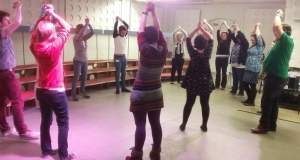 4 of the 5 tutors for the day
4 of the 5 tutors for the day
Last Sunday saw my third consecutive year as a tutor for the A Cappella Spring Fest at the Cornerstone Arts Centre in Didcot. The day took a similar shape to the previous years, with a plenary warm-up followed by themed classes and workshops in the morning, then afternoon rehearsals in a variety of a cappella genres, culminating in performances where we all shared our efforts.
I was leading the Contemporary A Cappella stream again this year, but with the added amenity of vocal percussion. Andy Frost from the Magnets ran two general workshops on beatboxing in the morning, and then during the afternoon coached a small group to add a vocal percussion part to Ben Bram’s arrangement of ‘Uptown Funk’.
It is a moderately challenging arrangement – though we had cut it down somewhat, given the short rehearsal time available – but participants took it well in their stride. It helps that the intricate parts that need rather more attention to get right come back at several points in the arrangement, so you feel it is worth investing the time in them, as you’ll get plenty of use out of that work. The passages aren’t expensive on a cost-per-sing basis, so to speak.





